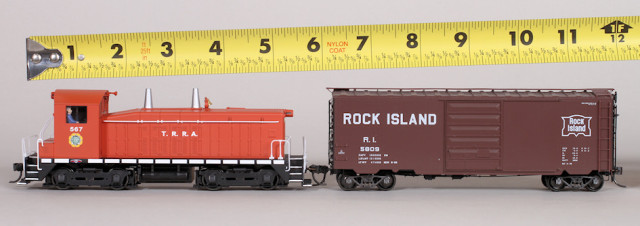Track Plan and Parts List
layout design, text, drawing and photos by Richard Schumacher
The Gateway Central XV layout was designed as a small switching layout the Division could easily take to train shows and other events to promote the hobby of model railroading. That layout was made as short as possible so as to be easily transported in the back seat of a car. As such, switching was made more complex (and the layout 6″ shorter) by having only one end of the run-around track able to hold both the switch engine and a car at the same time. While this makes it more interesting for switching contests and train show display, this “puzzle switching” limitation could “get old” pretty quickly on a home layout.
If you are interested in building this as a home switching layout, or as a switching extension for your existing home layout, the slightly bigger version on this page is recommended. Both ends of the run-around can hold both a standard diesel switch engine and a 40′ car at the same time. One more small industry has been added. And you can extend the layout (or connect to an existing layout) using the “main line” track (the middle one on the left side). Click any of the photos and drawings for a larger version.
The layout is designed for a standard diesel switcher and 40′ boxcars (at least four and up to seven, one could be a 40′ gondola instead of a boxcar). The ends of the run-around need to accommodate both the engine and a car. You must remember this when laying the track and if you add bumpers or end-of-track devices. You need to make sure there is slightly over 12″ between the run-around switch points and any bumper.
This layout uses Atlas code 83 track sections. The home version shown here is 14″ deep and 60″ wide. The grid lines on the diagram are spaced 12″ apart. You will want to make the layout slightly deeper if you plan to place a background on top of (as opposed to behind) the layout. All turnouts are Atlas code 83 #4 custom line. The size of the small track pieces are marked on the diagram (get the small pieces from Atlas, trying to cut your own from flex track is an exercise in frustration). Unmarked sections on the track plan are 6″ pieces. A section of code 83 flex track was cut into two pieces, their approximate lengths are marked on the diagram (measure on your railroad before cutting!). A rerailer section was incorporated into the plan because it makes that task easier, especially if children are operating the railroad. The rerailer is positioned so it may be sceniced as part of a road through the layout. You can use either a conventional DC or DCC throttle.
The structures are indicated by letter on the track plan. Photos of the assembled buildings, and any specific construction details for this layout (especially “C” and “E”), may be viewed by clicking the links.
This design uses Atlas code 83 track which has fine detail and a realistic look. For this switching layout, the track would normally be attached directly to the layout surface. If you use some sort of roadbed under the track, you will also need to raise all the buildings up by the thickness of the roadbed so the docks and dock doors align properly with the cars.
Quantity |
Part Number |
Notes |
| 1 | Atlas #519 rerailer | |
| 3 | Atlas #521 6″ straight (pk/4) | |
| 1 | Atlas #522 3″ straight (pk/4) | |
| 1 | Atlas #524 straight track assortment | Small track pieces |
| 3 | Atlas #561 #4 custom line switch left | |
| 3 | Atlas #562 #4 custom line switch right | |
| 1 | Atlas #500 super flex-track | Custom cut for two locations, see layout diagram |
| 1 | Atlas #553 terminal joiners | Electrical connection |
No insulated rail joiners are required for this track plan. Sufficient rail joiners to assemble this railroad are included with the Atlas track pieces. You will also need a throttle (either conventional DC or DCC), a small switching engine (an SW1, NW2, SW7, SW900, SW1200, SW1500, or MP15 diesel or an 0-4-0 or 0-6-0 tank engine – if you use a DCC throttle make sure the engine has a DCC decoder), and four to seven 40′ boxcars (note that the switching tracks are not long enough for 50′ cars, they were designed for 40′ cars).




















